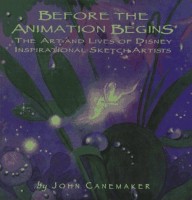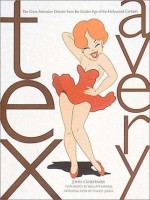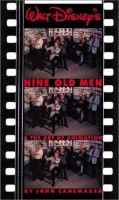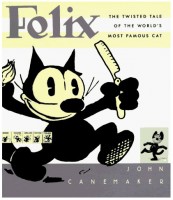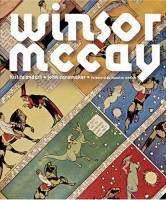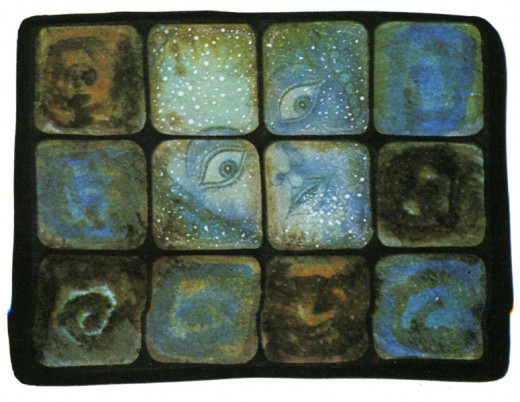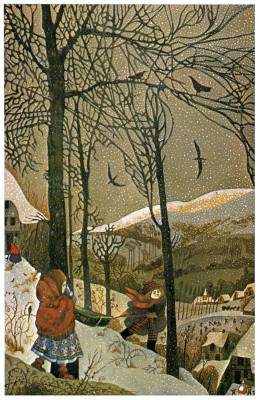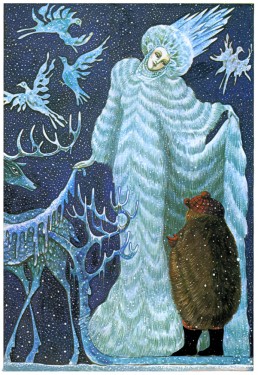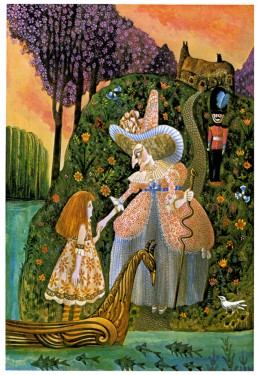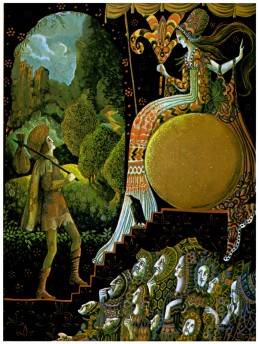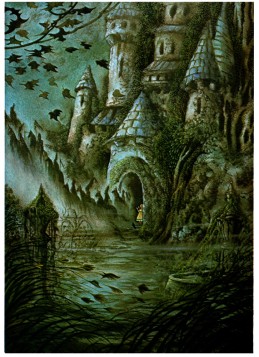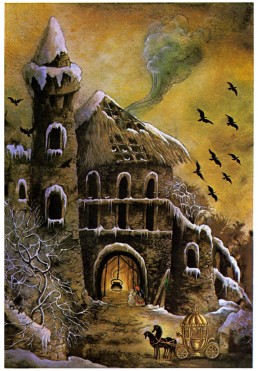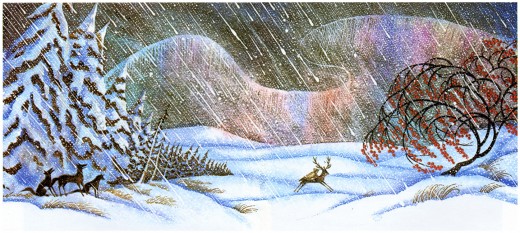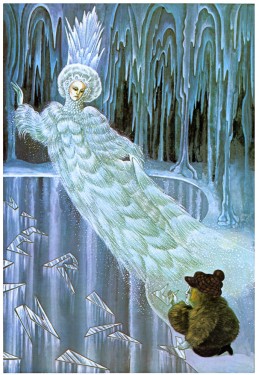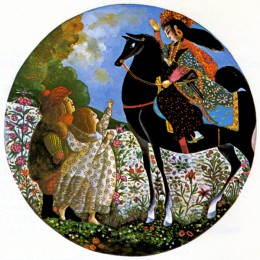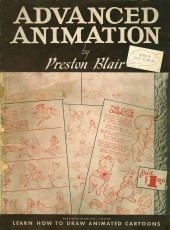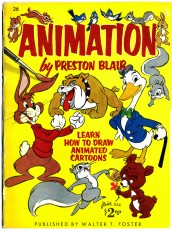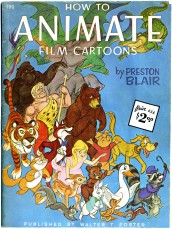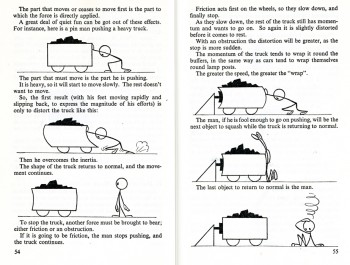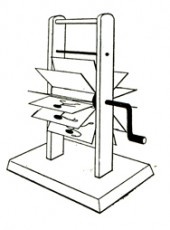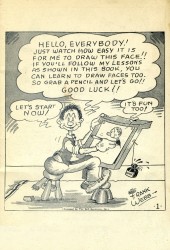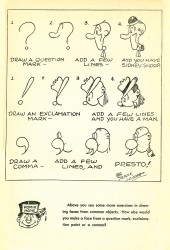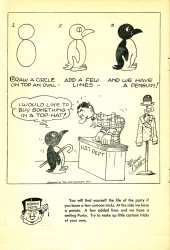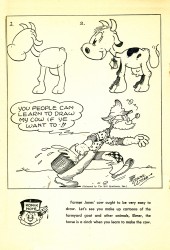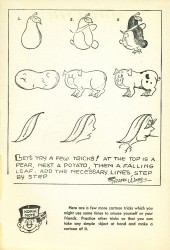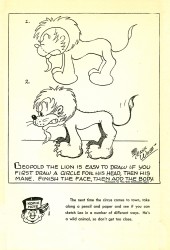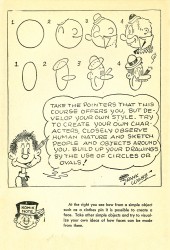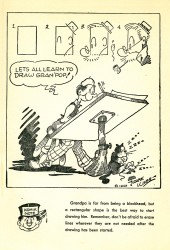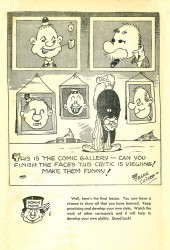Category ArchiveBooks
Books &Trnka 07 May 2007 08:13 am
Animation Bio Books
 – Before talking about animation books, let me congratulate the winners at last night’s ASIFA East awards. Don Hertzfeld, Patrick Smith, Nina Paley, Bruce Knapp and all of the other winners should feel proud of their work. Three cheers also for ASIFA East President David Levy, who did another excellent job of moderating the proceedings. My only complaint is that it’d be nice to see the food you eat; the party is too dark. Better than last year , but more lights, please.
– Before talking about animation books, let me congratulate the winners at last night’s ASIFA East awards. Don Hertzfeld, Patrick Smith, Nina Paley, Bruce Knapp and all of the other winners should feel proud of their work. Three cheers also for ASIFA East President David Levy, who did another excellent job of moderating the proceedings. My only complaint is that it’d be nice to see the food you eat; the party is too dark. Better than last year , but more lights, please.
The ASIFA East website will have a complete list of winners today.
- Continuing my thoughts on all the animation books out there (boy, there are a lot of them!), I thought I’d look at a couple of biographies. On April 16th, Amid Amidi posted on Cartoon Brew a listing of animation autobiographies he compiled on Amazon. Some of these are gems, some aren’t.
Not focusing on autobiographical books but rather on biographical ones, I’ve opened the door a tad to show some books that I’ve enjoyed and a couple I’ve loved.
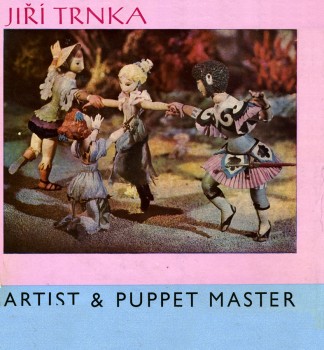 Let’s start with one of my favorite books. It’s no secret that I not only love puppets, but love animated puppet films. Far and above all the others, I find Jiri Trnka among the finest masters in animation and animation history. He took the animation puppet form and pushed it to new heights.
Let’s start with one of my favorite books. It’s no secret that I not only love puppets, but love animated puppet films. Far and above all the others, I find Jiri Trnka among the finest masters in animation and animation history. He took the animation puppet form and pushed it to new heights.
There are several books on Trnka’s work. I have three books and two folio publications on this artist. Jiri Trnka, Artist and Puppet Master by Jarolslav Bocek is an excellent book that was initally published in 1963 and in English in 1965. Because of the early date, several of his most important films aren’t included; specifically The Hand and The Archangel Gabriel and Mother Goose. Both were enormous films that had an enormous effect on animation puppet filmmaking.
However, this book focuses on his feature, Midsummer’s Night Dream (pictured on the book’s cover) and includes many excellent images from that film. In fact, there are quite a few illustrations in the book from many of Trnka’s films and illustrations. The book’s text is spare but quite effective in illustrating many of the important points in the life and work of this artist. It’s the illustrations that make this book a gem.
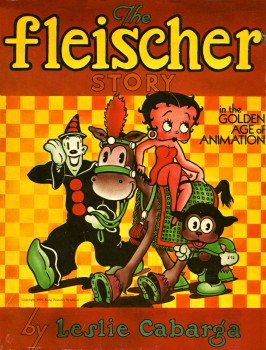 Another book that is made by its illustrations is Leslie Carbaga‘s book, The Fleischer Story. It’s an odd scrapbook of a biography of the Fleischers. Originally published in 1976 this book revealed a lot of information about the New York studio. It took them through the silent days right into the Florida studio and gets a bit odd about the final days of the studio.
Another book that is made by its illustrations is Leslie Carbaga‘s book, The Fleischer Story. It’s an odd scrapbook of a biography of the Fleischers. Originally published in 1976 this book revealed a lot of information about the New York studio. It took them through the silent days right into the Florida studio and gets a bit odd about the final days of the studio.
There is a large grab bag of black and white illustrations which show off a lot of the behind-the-scenes material the studio created in making their shorts. Model sheets, animation drawings, patent sketches, copies of the Fleischer Studio News in-house organ, and hi contrast photos are all pasted together in an unusual arrangement.
It really does feel a bit like a scrapbook of the studio, and it all serves to give you a lot of original material in the pre-internet days. Oddly, I can easily imagine this book as a website.
The original book didn’t quite deal with the whys and hows of the breakup, but by mailing to Carbaga he sent an amended letter to the chapter revealing information that he couldn’t tell until Dave Fleischer died. I’m not sure if the more recent copies of the book have been adjusted to include this gossipy information.
The Walter Lantz Story by Joe Adamson is an interesting little book not least because of 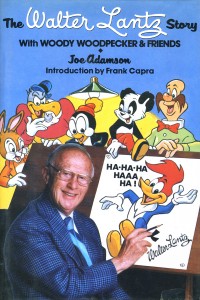 the odd introduction by Frank Capra. The book, like Lantz’ films, has a relaxed way of telling its story. In an almost casual manner, Adamson reveals the history of this animation pioneer.
the odd introduction by Frank Capra. The book, like Lantz’ films, has a relaxed way of telling its story. In an almost casual manner, Adamson reveals the history of this animation pioneer.
When I originally read it, I was surprised by the hard-core nuts and bolts that were revealed about the finances of the Lantz films. It was particularly interesting to me as an independent producer of animation. Somehow realizing that another of the established animation producers had suffered through difficult financial problems seemed somehow soothing. It’s a difficult game, and it’s always comforting to hear of others’ problems. In some way, they feel shared. I read this book as I went through a difficult patch, and it felt like every chapter of the book ended with more financial problems the Lantz studio was pushing through in their history.
Of course, a lot of important names are dropped in the Lantz history. Bill Nolan, Shamus Culhane, Tex Avery, Dick Lundy and LaVerne Harding all play an important part of the history. The book was obviously authorized by Walter and Gracie Lantz and almost feels as if they stood over Adamson’s shoulder as he wrote it.
It was also interesting back in 1985 to clear up some of the difficulties that spread through animation studios as one studio robbed from another both characters and personnel. I enjoyed seeing it sorted out, and this was one of the first to help clear the air of the Oswald the Rabbit theft and how the different bodies landed in the different studios. Today, of course, a reading of Michael Barrier‘s Hollywood Cartoons makes the history evident and clear. Except for some of the nitty gritty financial details and meticulous information about the Lantz studio, this book is almost superfluous now. In some ways it’s similar to the autobiographical tome by Bill Hanna. Just the same I not only enjoyed it but felt a strong connection to it.
- Of course, if you’re talking about animation biographies, you can’t omit the mass of titles of books by John Canemaker. Here are just a few that impress:
Before the Animation Begins: The Art and Lives of Disney Inspirational Sketch Artists This is one of my favorites of John’s books. Obviously, my heart is in design and his focus is on some key designers throughout the history of Disney animation. I just wish there were a sequel to this so that some more names could be revealed and analyzed.
Tex Avery: The Mgm Years, 1942-1955 There’s a wonderful French volume by Patrick Brion with the same title Tex Avery that is just beautifully produced with animation art on vellum and printed in color to highlight color pencil. Canemaker’s book isn’t quite up to this, but it’s wonderful on its own right giving complete attention to the MGM years of Avery’s work. The difference between the two copies I own, is that Canemaker’s book is in English, and I can understand it.
Walt Disney’s Nine Old Men and the Art of Animation gives the biographies of all nine animators Disney called his “Nine Old Men.” It’s amazing how much attention and photographic detail it gives to nine markedly dissimilar individuals.
Felix: The Twisted Tale of the World’s Most Famous Cat is by far the only real biography of the cat. In fact, it’s really more a biography of Otto Messmer, the quiet artist who drew most of the silent shorts for Pat Sullivan.
Winsor McCay : His Life and Art is the crème de la crème of Canemaker’s work. This book unveils all the material in this pantheon of cartoon creators. It’s an absolute must for all animation and comic strip lovers.
Books &Errol Le Cain 27 Apr 2007 08:10 am
Le Cain – The Snow Queen
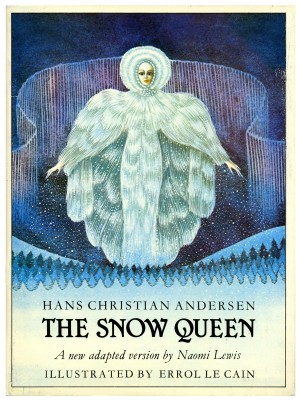 – I continue here to post some of the illustrations from another book by Errol LeCain.
– I continue here to post some of the illustrations from another book by Errol LeCain.
Errol was a longtime artist at Dick Williams’ Soho studio. He was the force behind the design and backgrounds of Dick’s endless feature film, The Cobbler and the Thief. When I first saw a BBC documentary about Dick’s work in the early 70′s, I was hooked on his films and his ambitions and his love of animation. The shorts I saw by Dick, including Love Me Love Me Love Me, only increased that excitement. In the BBC doc, there Dick talked about Errol LeCain as someone he’d taken under his wing and had him do the brunt of the work on the short film, The Sailor and the Devil. The short clip from this film made me a LeCain fan, and I started collecting his books.
In 1959, Columbia pictures released an animated feature of The Snow Queen. This was a reworked Russian animated film – interestingly enough, Dave Fleischer gets the credit for the reworking. The film was voiced by Tommy Kirk and Sandra Dee, and it came to me at a very impressionable age. Sleeping Beauty had taken hold of me, and 101 Dalmatians was on its way. I fell in love with this beautiful Russian film – even in the reworked version.
When LeCain’s book was released, I scarfed it up. I wasn’t disappointed by the stunning illustrations. About half of them follow:
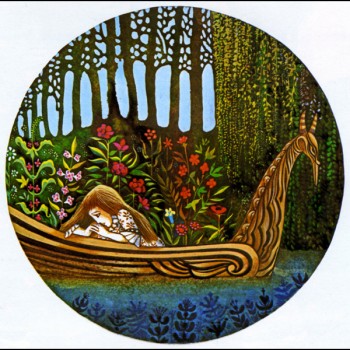
Books 25 Apr 2007 07:45 am
HOW-TO
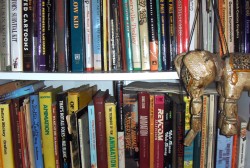 - We’re down to the nitty gritty with my book notes. There are so many books out there that it’s difficult to narrow down the books I like. I’ve talked about history of animation books; I’ve written about books out of print.
- We’re down to the nitty gritty with my book notes. There are so many books out there that it’s difficult to narrow down the books I like. I’ve talked about history of animation books; I’ve written about books out of print.
Today, I’d like to talk about HOW-TO books I like which are still available, and which I’d thoroughly recommend. By this, I mean books which tell how the nuts and bolts of animation are put together and that can get you inspired to do some hard work. None of these books are brand, spanking new; they’ve all weathered a bit of time and have proven themselves. They’re all still readily available, and I’ve given links.
- Dick Williams is an entity unto himself.
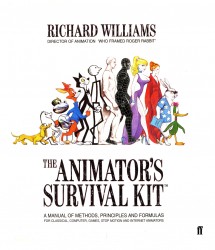 He was a dynamo in animation production for all those years he chose to make films. We all know about the legend of The Cobbler and the Thief and how the film was besmirched by the money lenders and takers. But the point behind Dick, it seems to me, is the people he inspired and the industry he rejuvenated single-handedly. For a while, thanks to the economic examples of Hanna-Barbera and Lou Scheimer, there was little good animation to be seen. The medium was in a desperate state with animators trying to imitate the horrible animation of the silent films of J.R.Bray when Dick Williams entered the scene and taught the world to love the work of the masters. He trained many animators to do great work, and he inspired hundreds of others.
He was a dynamo in animation production for all those years he chose to make films. We all know about the legend of The Cobbler and the Thief and how the film was besmirched by the money lenders and takers. But the point behind Dick, it seems to me, is the people he inspired and the industry he rejuvenated single-handedly. For a while, thanks to the economic examples of Hanna-Barbera and Lou Scheimer, there was little good animation to be seen. The medium was in a desperate state with animators trying to imitate the horrible animation of the silent films of J.R.Bray when Dick Williams entered the scene and taught the world to love the work of the masters. He trained many animators to do great work, and he inspired hundreds of others. 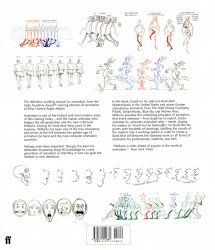
His legacy may be the book he developed which not only teaches, but it encourages and inspires.
Years ago, in the 70′s, the underground book that was passed around animaton was Dick’s lecture notes from the Art Babbitt lectures he’d hosted at his own studio in London. An ever-growing book of hundreds of xeroxed pages done in Dick’s own writing, the book took Dick’s own notes and made them useful to inbetweener trainees. (Somehow they seem more about how to inbetween than to animate.)
It’s obvious that Dick took these notes, cleaned them up and revised them to create his own book. And it’s excellent.
(The front and the back cover of the Williams book.
The back cover gives a good sample of what’s in it.)
In some ways, Dick’s book most reminds me of the Preston Blair book (see below).
It starts with basic principles of animation and movement and ultimately breaks into specific rules that have been developed over the years. The Blair book spends a lot of time trying to 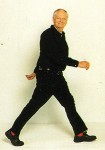 teach readers how to draw the traditional animation cartoon character. It does this prior to giving some real hard principles of animation layed out in a clear and simple way. The Williams book doesn’t spend as much time on the How-To-Draw part, but it does go into motion and has to be a gem for any neophyte animators out there.
teach readers how to draw the traditional animation cartoon character. It does this prior to giving some real hard principles of animation layed out in a clear and simple way. The Williams book doesn’t spend as much time on the How-To-Draw part, but it does go into motion and has to be a gem for any neophyte animators out there.
Get this book if you really want to know about animation, how things move and why. It’s a gem, and it doesn’t matter if you’re a 2D animator or a cgi animator. The principles are the same, and this book teaches you to respect those principles.
(Dick Williams always seems
to be walking in his photos.
.
The Williams studio in London created a British animation empire as well as a tradition that has thankfully slipped onto the rest of the world. A number of graduates of the Soho studio have developed their own world.
Tony White won the BAFTA award for his first solo Independent short, Hokusai. He eventually went into business for awhile and did some great commercial work.
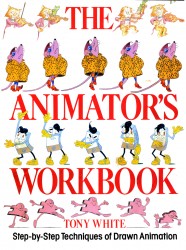 He also wrote and designed a brilliant book on animation, The Animator’s Workbook: Step-By-Step Techniques of Drawn Animation.
He also wrote and designed a brilliant book on animation, The Animator’s Workbook: Step-By-Step Techniques of Drawn Animation.
The book clearly and specifically gives lessons on animation and process. It’s attractively arranged and illustrated; the lessons are clear and certain; the information is supported by the experience of a gifted animator. I heartily recommend the book for the advanced animator as well as for the serious novice.
Tony has a second book which came out last year, Animation from Pencils to Pixels: Classical Techniques for the Digital Animator. I have to admit I haven’t purchased the book. An associate within my studio has a copy and says it’s much more complex in its layout and format. It comes with a dvd which illustrates the lessons in movement.
I have such respect for Tony and his work, that I’ll eventually buy the new book and will read it carefully. I can’t imagine his doing any better than he did with the first effor, but this gifted animator/director undoubtedly has a lot more to say, and I look forward to it.
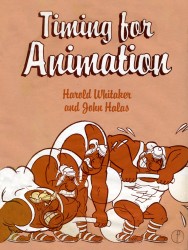 Another British animator whose book I’ve recommended several times in the past is Harold Whitaker. He was a gifted animator who worked at the Halas and Batchelor studio for many years, and he seems to have been the backbone of that studio in some of its later years.
Another British animator whose book I’ve recommended several times in the past is Harold Whitaker. He was a gifted animator who worked at the Halas and Batchelor studio for many years, and he seems to have been the backbone of that studio in some of its later years.
His book Timing For Animation has to be one of the finest books on 2D animation that I can recommend. I’ve said this on this site at least twice in the past – here and here – but I certainly have no compunction about plugging the book again.
I’ve posted the hardcover jacket but have linked to the paperback version. It’s a great book, and you should get it regardless of the version. I used to copy off pages as lesson-plans for the classes I taught at NYU. Go for it.
Finally, today, let me show you the book that started it all (not counting the 1920 Lutz book). Animator, Preston Blair, made himself famous among up-and-coming animators when he created an over- sized but slim, paperback book for the Walter T. Foster company. The book, Animation by Preston Blair, was designed to be sold in art stores and was featured at a very low price.
The book, over the years, has come in many different covers. For a while, they sold it at a higher price combining it with a slightly more advanced version done by Blair and retitling it to Cartoon Animation (The Collector’s Series).
It’s still the best bang for the buck.
Actually, you don’t even have to buy it. Go to ASIFA Hollywood Animation Archive and download a copy for yourself (print it out if you like.) I also suggest you follow the course they suggest in conjunction with John Kricfalusi. There’re a lot of interesting bloggers out there showing off their versions of Blair’s drawings/walk cycles and animation. You can’t help but learn from it. Start here and advance your way through it. The brilliance of the internet in action.
Books 17 Apr 2007 07:52 am
How-To Books – part one
- It’s time to talk about books that try to tell you how to make animated cartoons. For better or worse, my interest is in 2D animation of the old fashioned kind. I don’t know enough about cgi animation to know if a book is good, so I won’t talk about them. I don’t like Flash animation, as it exists now, so I’ve never looked at a book about that method of production. I couldn’t tell you what I think is a good book, since I don’t know of any. (Yes, I know my bias is somewhat elitist, but that’s something I’m not going to apologize for. I’m a 2D guy, and can’t change that. I also love puppets and have worked in stop motion, hence I’ll broach that subject, too.) I love the old kind of animation, am glad to be doing it on a computer – using the most modest of methods – so that’s all that I can discuss. What I know.
Saying that. Here’s my first of the How To posts. There are so many books out there, that I couldn’t do it all in one shot. I’m going to start by talking about books that are hard to find.
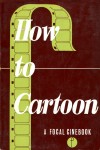 - At one time John Halas was the grandaddy of animation writers. He wa enormously prolific with a number of successful books on how to make animated films. His book, How To Cartoon for Amateur Films was the first, done in 1951 with Bob Privett.
- At one time John Halas was the grandaddy of animation writers. He wa enormously prolific with a number of successful books on how to make animated films. His book, How To Cartoon for Amateur Films was the first, done in 1951 with Bob Privett.
This book is a pocket sized paperback with lots of simple little pen & ink illustrations showing how to build a camera, how to draw with arcs and all the materials you’ll need. The book, to me, seems excessively detailed and complicated since it’s trying to speak to “amateurs.”
Some of the illustrations are priceless. Here are two:
 – Of course, Halas‘ finest book was The Technique of Film Animation which he wrote with Roger Manvell. This book covers all aspects of animation (done in 1959 when it was first publilshed) from cel to cutout to stop-motion.
– Of course, Halas‘ finest book was The Technique of Film Animation which he wrote with Roger Manvell. This book covers all aspects of animation (done in 1959 when it was first publilshed) from cel to cutout to stop-motion.
The illustrations in the book are so engrained in my subconscious that I pull them out as reference often. (Just recently when a friend was looking for animation references on fire, I emailed her as one example, the series of Goofy cels holding the Olympic torch (interestingly the authors mistakenly attribute them to Clock Cleaners) on page 195. Everyone owns this book, don’t they? If not stop wasting time and get a copy somewhere. Try a discount used-book shop like the Strand.
The oddest part of this book is the article in the back of the book by Brian G.D. Salt., Mathematics In Aid of Animation. I’ve always considered myself fairly good at math, but somehow I’ve never been able to understand this chapter. I must have tried reading it a dozen times. I’m sure it’s just me, but I don’t mind admitting it. Somehow, I don’t feel as if I’m missing anything.
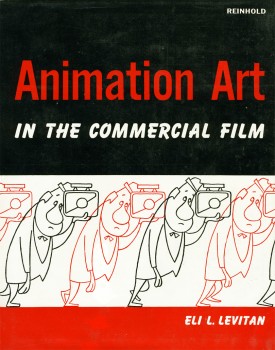 – Eli Levitan, who started in the business as an errand boy at Fleischer’s, wrote a number of books that were all nuts and bolts and never inspired me. Just the same, I still think of them as an important part of my past. His book Animation Art in the Commercial Film is a book I gave some attention to in the past, and I suggest you go to that post to get more information about this book. Check it out here.
– Eli Levitan, who started in the business as an errand boy at Fleischer’s, wrote a number of books that were all nuts and bolts and never inspired me. Just the same, I still think of them as an important part of my past. His book Animation Art in the Commercial Film is a book I gave some attention to in the past, and I suggest you go to that post to get more information about this book. Check it out here.
It’s interesting that Levitan also wrote one of the first consumer books about computer animation in 1977. This book has a big title: Electronic Imaging Techniques: A Handbook of Conventional and Computer-Controlled Animation, Optical, and Editing Processes.
- Finally let me point to a book that I’m not really going to recommend since its information  is so basic, but it did interest me for years. E.G. Lutz wrote Animated Cartoons, How They Are Made Their Origin and Development back in 1920. Back in my younger years, this book was referenced more often than any other by the great animators of the Golden Age. Everyone from Chuck Jones to Walt Disney to Walter Lantz to Bob Clampett mentioned it in interviews I’d read. It became a mission of mine to find the book. My local library in New York didn’t have one, so I kept my eyes open. Eventually, I was able to find one from a rare book dealer, but that happened long after I was well settled in the business.
is so basic, but it did interest me for years. E.G. Lutz wrote Animated Cartoons, How They Are Made Their Origin and Development back in 1920. Back in my younger years, this book was referenced more often than any other by the great animators of the Golden Age. Everyone from Chuck Jones to Walt Disney to Walter Lantz to Bob Clampett mentioned it in interviews I’d read. It became a mission of mine to find the book. My local library in New York didn’t have one, so I kept my eyes open. Eventually, I was able to find one from a rare book dealer, but that happened long after I was well settled in the business.
The book does have a lot of basic information and must have been a real revelation in 1920 to so many people. I guess it was the only book that was available at the time, so it’s understandable how many people back in the silent era were influenced.
A company called Applewood Press reprinted it in 1998, so it’s easy to locate in its reprinted version. hell, now you have the internet, so the original version can be found fairly easily.
Books 14 Apr 2007 08:43 am
More Animation Books
- There aren’t too many books that deal with the business of animation, social relations, getting a job, etc. When I was young there were many books about cartooning that showed various jobs available to potential cartoonists:
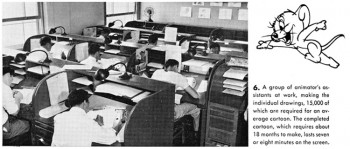 One book: The Complete Guide to Professional Cartooning by Gene Byrnes is a good example of this. It had a whole chapter on “How Animated Cartoons Are Made” featuring lots of photographs from the MGM studio with particular focus on a Tom & Jerry cartoon. Fortunately this chapter of the 1950 book was posted by Dave King on his website: www.sweaterthieves.com.
One book: The Complete Guide to Professional Cartooning by Gene Byrnes is a good example of this. It had a whole chapter on “How Animated Cartoons Are Made” featuring lots of photographs from the MGM studio with particular focus on a Tom & Jerry cartoon. Fortunately this chapter of the 1950 book was posted by Dave King on his website: www.sweaterthieves.com.
I memorized this book when I was a kid, and it’s great to see it again. I was never really a big fan of Tom & Jerry cartoons, but the images in this book perfectly capture, for me, everything I assumed it meant to be working in an animation studio. I still remember another photo or two that I don’t see posted on the site. The memory of one of those pictures always gives me a jolt of a smile sending me back to the good-old-days of cel animation (not 2D computer animation.)
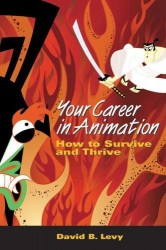 But if we’re talking about books available today, I only really know of one to recommend. Dave Levy‘s book, Your Career In Animation: How To Survive and Thrive is a great one. I have to admit the title turned me away originally since I thought it was another book for complete neophytes. It’s not; it’s much more.
But if we’re talking about books available today, I only really know of one to recommend. Dave Levy‘s book, Your Career In Animation: How To Survive and Thrive is a great one. I have to admit the title turned me away originally since I thought it was another book for complete neophytes. It’s not; it’s much more.
This book offers general ideas which would help out anyone going into any career. David’s focus, however, is on animation: getting a job and how to survive once you get a job. It’s full of smart information and a lot of wit. I wholeheartedly recommend it for beginners as well as those working in the business. The author is a genial guy, and his manner comes across pleasantly in his writing style.
Shamus Culhane was a long-time animator and director of cartoons who owned his own studio in New York (and for a while in Italy.) He wrote two interesting books before he died in 1996. They have a different focus from each other, but there’s a lot of overlap. Both are entertaining reads.
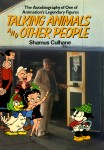 Talking Animals and Other People is Shamus’ autobiography; it’s his version of his own history in the world of animation. The book is a well-written insider’s view into what it was like working in some of the studios during the “Golden Age.” It’s been years since I’ve read these two books; this is how I remember them.
Talking Animals and Other People is Shamus’ autobiography; it’s his version of his own history in the world of animation. The book is a well-written insider’s view into what it was like working in some of the studios during the “Golden Age.” It’s been years since I’ve read these two books; this is how I remember them.
There’s plenty of attitude and personality, as one might have expected from the author, and he articulates many stories about his experiences. However I’m not sure how reliable the history is. It’s not unlike an interesting interview with an animator; the stories aren great but sometimes the memory makes for an unreliable source. While reading it, I felt like I should be running to locate back-up sources to check it all out. There are good stories here, though, and there’s no doubt the man was there.
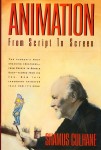 Animation: From Script to Screen gives an account of the different aspects of animation production and tries to fully detail what each of those jobs involves. Shamus wore many hats in the business and he uncovers aspects behind it all.
Animation: From Script to Screen gives an account of the different aspects of animation production and tries to fully detail what each of those jobs involves. Shamus wore many hats in the business and he uncovers aspects behind it all.
This book doesn’t have quite the attitude and personality of his first book, but it does give a good coherent breakdown of the work-a-day business behind animation. There’s a decent overview of world animation Shamus knew at the time. Published in 1988, the book obviously doesn’t spend a lot of time on the computer, but it gives a good view of animation. Both books have lots of illustrations, and many of them are interesting. The printing on the illustrations isn’t the best.
Next week we’ll finally get to the How-to books.
Books 12 Apr 2007 07:03 am
More history books
- Of course, once you open a can of worms, lots of critters wander out unexpectedly.
I started writing about animation books with a focus on the history books, but I reealized there were many more books that I should list.
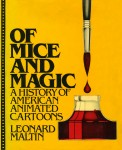 Leonard Maltin‘s Of Mice and Magic originally came out in 1980 and has had a number of revised editions. It was the first big-time book to call itself a “History of Animated Cartoons,” and it does a good job of cataloging a lot of material and reporting on it. The book puts the films in order by studio which is, in some ways, helpful. This is especially true if you’re searching for information about a specific film. Jerry Beck had a large hand in writing this book.
Leonard Maltin‘s Of Mice and Magic originally came out in 1980 and has had a number of revised editions. It was the first big-time book to call itself a “History of Animated Cartoons,” and it does a good job of cataloging a lot of material and reporting on it. The book puts the films in order by studio which is, in some ways, helpful. This is especially true if you’re searching for information about a specific film. Jerry Beck had a large hand in writing this book.
The best part of the book is the attention it gives to some of the New York studios: Terrytoons and Paramount, in particular. These studios are usually given short shrift by animation histories; there’s just so little written about them.
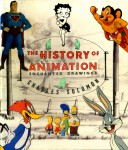 Charles Solomon wrote a larger – more of a coffetable book – history of animation. Enchanted Drawings: The History of Animation covers the traditional American Studio history and attacks it in a mostly chronological order. However, the book also gives large focus to the International and Independent scenes. These are traditionally ignored in most of the books, yet, here, they’re discussed in some detail in a confident, articulate style. Plenty of beautiful, color illustrations fill the book and add to its value.
Charles Solomon wrote a larger – more of a coffetable book – history of animation. Enchanted Drawings: The History of Animation covers the traditional American Studio history and attacks it in a mostly chronological order. However, the book also gives large focus to the International and Independent scenes. These are traditionally ignored in most of the books, yet, here, they’re discussed in some detail in a confident, articulate style. Plenty of beautiful, color illustrations fill the book and add to its value.
You can get a good indication of the caliber of this book from its cover. The characters illustrated come in many forms, yet in every case the best looking versions of these characters was chosen. There’s good taste in this book from cover to cover.
There are two books about Silent film animation. Other than the Canemaker books on Winsor McCay and Felix the Cat, these are the only two books I’d like to highlight, and they’re both important ones.
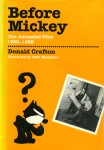 With Before Mickey, Donald Crafton has written a very strong book on the history of silent animated films. He carefully points to all of the great and not-so-great animation filmmakers and studios. From Winsor McCay to J.R.Bray to Otto Messmer, Crafton doesn’t miss much, and if he does, I can’t find it. Given the difficulty just in viewing many of these films it’s easy to say that the amount of research for this book was obviously enormous.
With Before Mickey, Donald Crafton has written a very strong book on the history of silent animated films. He carefully points to all of the great and not-so-great animation filmmakers and studios. From Winsor McCay to J.R.Bray to Otto Messmer, Crafton doesn’t miss much, and if he does, I can’t find it. Given the difficulty just in viewing many of these films it’s easy to say that the amount of research for this book was obviously enormous.
Since I have a real curiosity about the period, I found the book riveting. Few people have seen many of the films discussed, so it’s not a book that many are going to want. However, I’m pleased that it is one of the most solid animation histories out there. If I have any complaints it’s that the writing style is a bit dry, but that’s quibbling. I treasure the book.
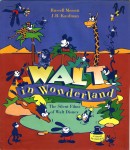 Walt In Wonderland is necessary to any big Disney fans. Russell Merritt and J.B. Kaufman have done a brilliant job on this book. It gives strong attention to the silent films of Disney: the Alice comedies and the Oswald shorts. There’s a good history of the studio from Kansas City to Hollywood with lots of illustrations.
Walt In Wonderland is necessary to any big Disney fans. Russell Merritt and J.B. Kaufman have done a brilliant job on this book. It gives strong attention to the silent films of Disney: the Alice comedies and the Oswald shorts. There’s a good history of the studio from Kansas City to Hollywood with lots of illustrations.
The book not only features a history of the studio, but it shows the production methods used and invented in what was an ever-changing process back then.
Merritt and Kaufman have a more recent book, Walt Disney’s Silly Symphonies: A Companion to the Classic Cartoon Series, is a book I have on order and haven’t yet read. If what I’ve heard about it is accurate, I expect it’ll be another great book. Once I’ve read it, I’ll let you know what I think.
Next time, finally, books about the craft rather than the history.
Books &Comic Art 11 Apr 2007 07:44 am
Even More Pigs
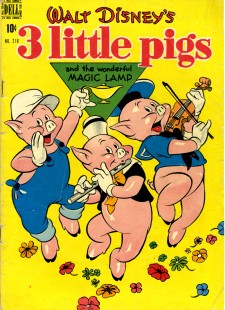 – I used to love comic books when I was a kid. I read them incessantly. It grew to become an enormous thing between me an my father when he absolutely banned them in the house. Comic books back in the 50s, everyone knew, rotted out the minds of little children. I couldn’t resist and continued to sneak them into my room. I couldn’t get enough of Donald Duck or Unca Scrooge or, even, Little Lulu.
– I used to love comic books when I was a kid. I read them incessantly. It grew to become an enormous thing between me an my father when he absolutely banned them in the house. Comic books back in the 50s, everyone knew, rotted out the minds of little children. I couldn’t resist and continued to sneak them into my room. I couldn’t get enough of Donald Duck or Unca Scrooge or, even, Little Lulu.
One of my earliest memories comes from myself at the age of 8 trying to imagine what this genius, Walt Disney, looked like. This is before the Disneyland television show, before the media and PR hounds poured into the mind of an 8 year old child. I mean Walt Disney signed those comics – his script name appeared just above the Donald Duck masthead on the cover – he was the one responsible.
(Click any image to enlarge.)
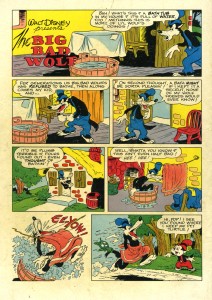 Well, I’ll tell you what I imagined:
Well, I’ll tell you what I imagined:
An oddball version of Farmer Alfalfa (that must be what Disney looked like) stood at a large, Rube Goldberg-like machine, right out of the Industrial Revolution, and he turned out these books on a conveyor belt. That’s all I remember about it, but I do remember it. Obviously, my father was right. My mind was rotting away.
I was finally caught. It was a large, Special issue comic book. “Dennis The Menace Goes To Hawaii.” That was it, and I was punished. Two weeks to bed early without television didn’t stop me, and somehow it seemed alright a few weeks later to read comics again. My comic book craving continued. I didn’t collect them; I just read them and appreciated the drawing. (They were well drawn back then.)
The back cover
So now, every once in a while, I come upon a rarity
on ebay and can’t help myself. A few months ago I found
this Three Little Pigs comic book and had to have it. I didn’t even know there were Three Little Pigs comics! It was published in 1949.
I’m amazed at how successful The Pigs were. The short was released in 1933. Before television how did the legacy live on long enough to keep them popular?
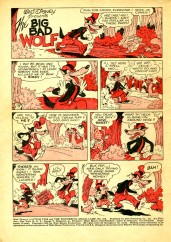
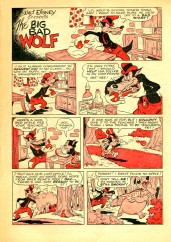 There were only a couple of other shorts with the same characters:
There were only a couple of other shorts with the same characters:
The Big Bad Wolf 1934,
The Three Little Wolves 1936, and
The Practical Pig 1939.
The last, prior to 1949, was a WWII educational short, The Thrifty Pig in 1941.
Eight years later this comic book appeared.
55 years later, I bought a copy. Still rotting my brain.
There were no ads in the magazine back then. These are the
inside covers, front and back.
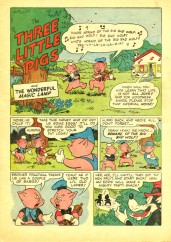 1
1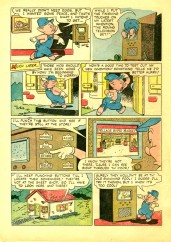 2
2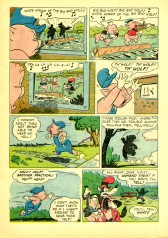 3
3
The comic book incorporates other characters from the Disney fold. The witch from Snow White appears when it’s convenient, and Br’er Bear appears.
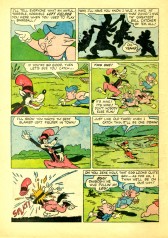 4
4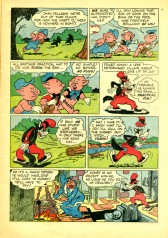 5
5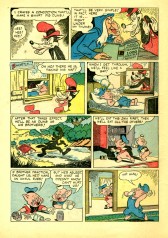 6
6
The above are the first six pages of the story. It’s the first of three stories in the 32 page comic book.
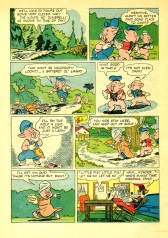 14
14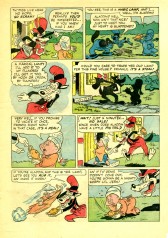 15
15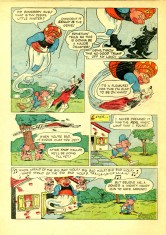
These are the last three pages of the story. I just wanted to give a taste of the comic.
Books &Mary Blair 10 Apr 2007 08:12 am
Animation History Books
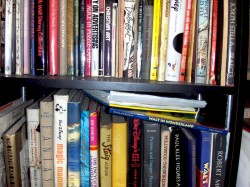 – In a letter from a friend, I was asked to recommend some animation books. That’s always a hard thing to do. Hard because I like things about books that aren’t necessarily things others like or are searching for. Hard because reading, to me, is such an individual preference that I know my likes aren’t going to please most others. And hard because so many books are written by friends whose work I admire – making me feel guilty (for no good reason) for recommending them – as if it were a bias on my part just because they’re friends. It’s particularly hard these days because there are so many good books coming out every day, and there are just too many books to point out. For that reason, I’m going to talk primarily about books I love – regardless of their availability.
– In a letter from a friend, I was asked to recommend some animation books. That’s always a hard thing to do. Hard because I like things about books that aren’t necessarily things others like or are searching for. Hard because reading, to me, is such an individual preference that I know my likes aren’t going to please most others. And hard because so many books are written by friends whose work I admire – making me feel guilty (for no good reason) for recommending them – as if it were a bias on my part just because they’re friends. It’s particularly hard these days because there are so many good books coming out every day, and there are just too many books to point out. For that reason, I’m going to talk primarily about books I love – regardless of their availability.
Saying all that, I also have to say that I’ve been thinking about such a post (or two) for a while, and I didn’t need too much encouragement. I love books. My studio is overrun with them; my apartment is overrun with them. Bookshelves are overstuffed, floors have piles on top of piles. I spent many years as a child in libraries going through art, animation and illustration books, lusting after so many of them. When I grew old enough to afford any, I started buying. So these are some of the books I love.
My all time favorite animation books include two impossible to get
classics:
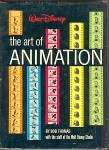 Bob Thomas‘ The Art of Animation. I’m only talking about the 1959 version, the one that promotes Sleeping Beauty, not the reworked versions they did for later features. I think I favor this book so much because it was the first big-deal animation book I ever owned (and read till the book just about fell apart.) The book gives a good overview of animation’s processes and methods and gives a sense of history to the subject. I learned so much from this book that I can’t properly evaluate it. I also may have read a lot inbetween the lines, but I got a lot out of it. Unfortunately, this book is out of print and is hard to find though I recently bought another copy of this book on ebay.
Bob Thomas‘ The Art of Animation. I’m only talking about the 1959 version, the one that promotes Sleeping Beauty, not the reworked versions they did for later features. I think I favor this book so much because it was the first big-deal animation book I ever owned (and read till the book just about fell apart.) The book gives a good overview of animation’s processes and methods and gives a sense of history to the subject. I learned so much from this book that I can’t properly evaluate it. I also may have read a lot inbetween the lines, but I got a lot out of it. Unfortunately, this book is out of print and is hard to find though I recently bought another copy of this book on ebay.
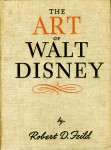 Robert Feild’s The Art of Walt Disney was an historical oddity that my local library had when I was young. It was published in the arly 40s and illustrates, in a somewhat formal way, the art of Disney’s early classic features. No artists are identified, no credit is given to anyone other than Disney.
Robert Feild’s The Art of Walt Disney was an historical oddity that my local library had when I was young. It was published in the arly 40s and illustrates, in a somewhat formal way, the art of Disney’s early classic features. No artists are identified, no credit is given to anyone other than Disney.
However, the book was so much a part of my childhood that I cherished it and was so proud when I finally was able to afford a rare copy I found at a used book seller back in the 60s. Elelments of animation that didn’t appear in the Thomas book were here: real art direction roughs, real animation roughs. Oddly both books feature sections on storyboards that were eliminated. I love them both.
Now to books that are more readily available – especially on-line – that I relish more for the material within than the nostalgia factor. However, just as I was significantly influenced by the above two books, I suspect the following are affecting new generations of animators:
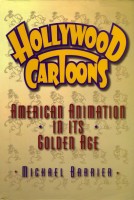 Mike Barrier‘s Hollywood Cartoons: American Animation in Its Golden Age is for animation fans as well as history buffs. Barrier is an articulate, knowledgeable, well-researched author who puts everything he has into his writing. He backs up his research with a monstrous collection of interviews with all the greats he writes about. His books aren’t big coffeetable tomes stuffed with great images; he writes about artists, animators and studios in a sophisticated way unearthing bits of history that add up to a sharp and dynamic picture of everyone or every film he focuses on.
Mike Barrier‘s Hollywood Cartoons: American Animation in Its Golden Age is for animation fans as well as history buffs. Barrier is an articulate, knowledgeable, well-researched author who puts everything he has into his writing. He backs up his research with a monstrous collection of interviews with all the greats he writes about. His books aren’t big coffeetable tomes stuffed with great images; he writes about artists, animators and studios in a sophisticated way unearthing bits of history that add up to a sharp and dynamic picture of everyone or every film he focuses on.
In a year, when I was despondent over the state of animation – particularly the work going (or not going) through my studio, this book is the only thing that kept me inspired and hopeful about animation and its possibilities. But that’s a very personal thing, and I make no bones about it. I’ve reread this book sevaral times and will do again. There’s just so much in it. 
Michael Barrier has also just seen his new book, The Animated Man, A Life of Walt Disney, released. I won’t review it here since I’ve just started reading it, but I’m totally hooked only fifty pages into it. I didn’t like the recent biography by Neal Gabler (I couldn’t get through it), but this is totally engrossing. I’ve read Disney’s life story what seems a million times over, so I’m amazed at how captivated I am.
When I’ve finished reading I’ll have more to say about it, but don’t wait for me. If you like Disney, like accurate history, like animation and want a good read, buy it.
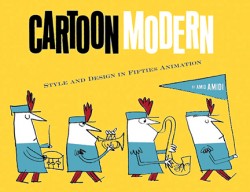 Amid Amidi has contributed a completely original title to the compendium of animation history with his book, Cartoon Modern: Style and Design in 1950s Animation. This is one of the finest art books with a focus on animation. It’s a treasure of glorious illustrations of hard to find films (never mind the actual artwork from the films) from the 50s and early 60s, with the analysis on the design in the films. Since these films were more about their design than their animation, this makes perfect sense. The organization within the book is a bit peculiar, but that’s expected given the numerous designers and studios involved. It’s become one of my treasures since its publication last year.
Amid Amidi has contributed a completely original title to the compendium of animation history with his book, Cartoon Modern: Style and Design in 1950s Animation. This is one of the finest art books with a focus on animation. It’s a treasure of glorious illustrations of hard to find films (never mind the actual artwork from the films) from the 50s and early 60s, with the analysis on the design in the films. Since these films were more about their design than their animation, this makes perfect sense. The organization within the book is a bit peculiar, but that’s expected given the numerous designers and studios involved. It’s become one of my treasures since its publication last year.
Animation inspires heavy duty coffee table books. John Canemaker is the king of beautiful books filled with excellent artwork telling the stories about the world of animation. John’s books are the closest to the classics I found as a child, the Thomas and Feild books, and I can only guess at how many kids were turned onto animation because of his writing.
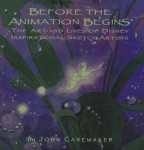 His Disney classics include: Walt Disney’s Nine Old Men (the story of the nine principal animators that Disney liked to focus on during the 50′s) and Paper Dreams: The Art and Artists of Disney Storyboards and The Art and Flair of Mary Blair (a focus on one specific Disney designer.) These are all filled with choice illustrations that are hard to find elsewhere (even on the internet) and lots of specific information that is informed and key to the history of Disney’s greatest films. My particular favorite among the books is relative to my specific interest in animation: design. The book, Before The Animation Begins, tells the story of Disney’s inspirational art directors and designers. It’s a beauty; well conceived, written, and designed.
His Disney classics include: Walt Disney’s Nine Old Men (the story of the nine principal animators that Disney liked to focus on during the 50′s) and Paper Dreams: The Art and Artists of Disney Storyboards and The Art and Flair of Mary Blair (a focus on one specific Disney designer.) These are all filled with choice illustrations that are hard to find elsewhere (even on the internet) and lots of specific information that is informed and key to the history of Disney’s greatest films. My particular favorite among the books is relative to my specific interest in animation: design. The book, Before The Animation Begins, tells the story of Disney’s inspirational art directors and designers. It’s a beauty; well conceived, written, and designed.
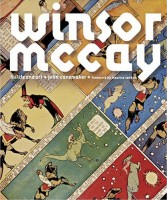 John Canemaker has non-Disney books as well. Two of them classic treasures among animation books. Winsor McCay : His Life and Art is the only significant book to put such a fine-tuned focus on animation’s first, great artist. There’s a wealth of material in this book with stunningly valuable illustrations. McCay deserved nothing less than the brilliance he put into his films, and Canemaker delivers.
John Canemaker has non-Disney books as well. Two of them classic treasures among animation books. Winsor McCay : His Life and Art is the only significant book to put such a fine-tuned focus on animation’s first, great artist. There’s a wealth of material in this book with stunningly valuable illustrations. McCay deserved nothing less than the brilliance he put into his films, and Canemaker delivers.
In Felix: The Twisted Tale of the World’s Most Famous Cat John gives the proper attention to the brilliant cartoonist Otto Messmer who did the hard work of supervising and drawing Felix to stardom. This is animation’s first big star, and the book shows you why.
I’ll post some favorite non-history/historical books later this week.
Books 18 Mar 2007 08:21 am
More Faces of Frank Webb
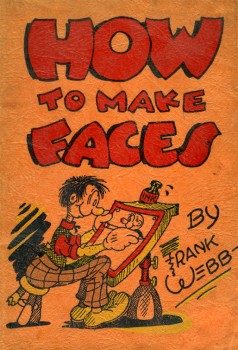 – Last August, I posted bits of the book How To Make Faces which I am pleased to own. It comes from a completely different era, and contains drawings which remind me of my childhood. Romps to the public library rummaging through any book that had whatever remote connection to animation or cartooning.
– Last August, I posted bits of the book How To Make Faces which I am pleased to own. It comes from a completely different era, and contains drawings which remind me of my childhood. Romps to the public library rummaging through any book that had whatever remote connection to animation or cartooning.
I vaguely remember seeing this book there and was happy to find it on ebay. Every so often I flip through it and smile at the drawings. There’s some funny work there, and I wonder how many kids used it to try to learn how to draw cartoons.
Just this past week I received an interesting comment on that post; here it is:
-
Hi,
Frank Webb was my great uncle, and I am very pleased to have found someone who still knows of him. I have a bunch of his stuff, and know a bit about his history, including him publicly proclaiming Walt Disney a crook! One of Franks drawings ended up in a sale to Disney, and renamed (from “Dippy Dogâ€) to Goofy. Thank you for including him here.
Darren Reese
This was just the excuse I needed for sharing a bit more of this booklet. I didn’t see any resemblance of Dippy Dog, but there is a guy who looks a bit like Farmer Alfalfa. I hoped I wasn’t alone in appreciating Mr. Webb’s cartoons, and now I know I’m not. Here are a few more pages. In the pages I posted last time, Frank Webb showed how to make cartoons from letters of the alphabet. This time he works in a more traditional manner.
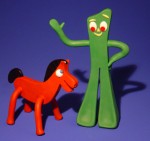 – Speaking of Old Timers, Gumby celebrated his 50th birthday last week. All 200 episodes of the “Gumby Show” will be released in dvd this fall. However you can watch episodes of the show for free at AOL or YouTube.
– Speaking of Old Timers, Gumby celebrated his 50th birthday last week. All 200 episodes of the “Gumby Show” will be released in dvd this fall. However you can watch episodes of the show for free at AOL or YouTube.
A remastered version of the 1995 “Gumby Movie” will premiere next month at the Tribeca Film Festival in New York.
Congratulations to Art Clokey. Still going strong.
Animation Artifacts &Books &Luzzati & Gianini 08 Feb 2007 07:59 am
Luzzatti Monograph
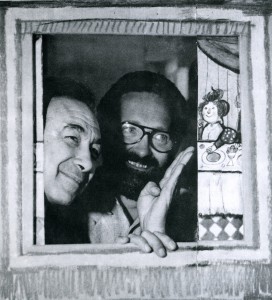 – Continuing my series on Emanuele Luzzati, who died last Thursday, I want to point some attention to an Italian monograph, published in 1983, on Luzzati and his partner, Giulio Gianini.
– Continuing my series on Emanuele Luzzati, who died last Thursday, I want to point some attention to an Italian monograph, published in 1983, on Luzzati and his partner, Giulio Gianini.
This book by Sara Cortllazzo is Pastelli Pupazzi e Siparietti, Il Cinema di Gianini e Luzzati. Its primary usefulness is the complete filmography which makes up the latter half of the book.
(You can read a digital translation of Gianni Rondolino’s introduction to this here.)
The book is illustrated with a number of B&W frame blow ups from the films. There are a couple of original pieces which I post here:
Luzzati on the left, Gianini on the right.
(All images enlarge by clicking them.)
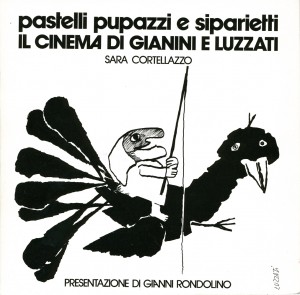 2
2 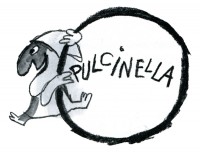 3
3
2. The book’s cover features the Thieving Magpie ridden by Pulcinella, their two Oscar nominees.
3. This is a small sketch of Pulcinella (Punch) from the film Pulcinella.
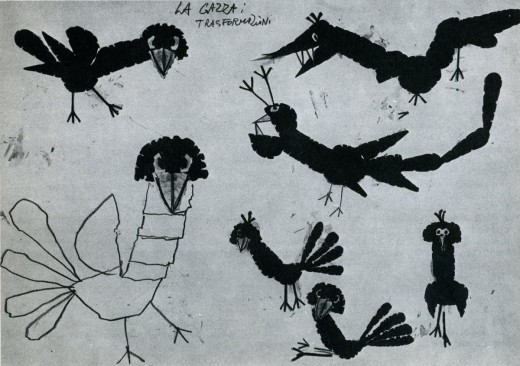
A model for the magpie from The Thieving Magpie.
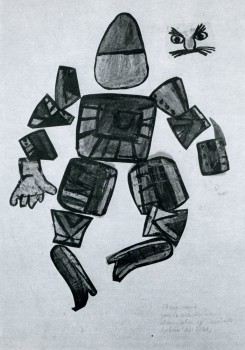 5
5 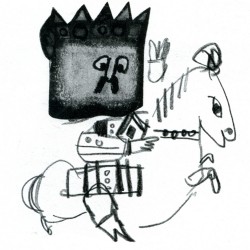 6
6
5. A character sheet from their short, Ali Baba. You can see exactly how the pieces will be cut and reconstructed to animate the character under the camera. (Not too far from Flash.)
6. A character sketch from the short, The Paper Castles.
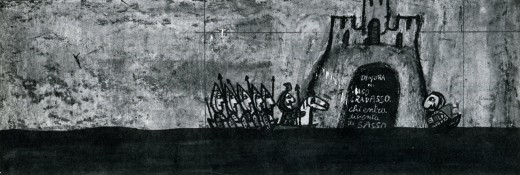
A background setup from The Paladins of France.
